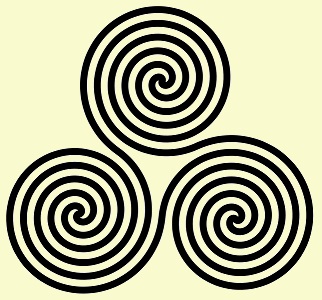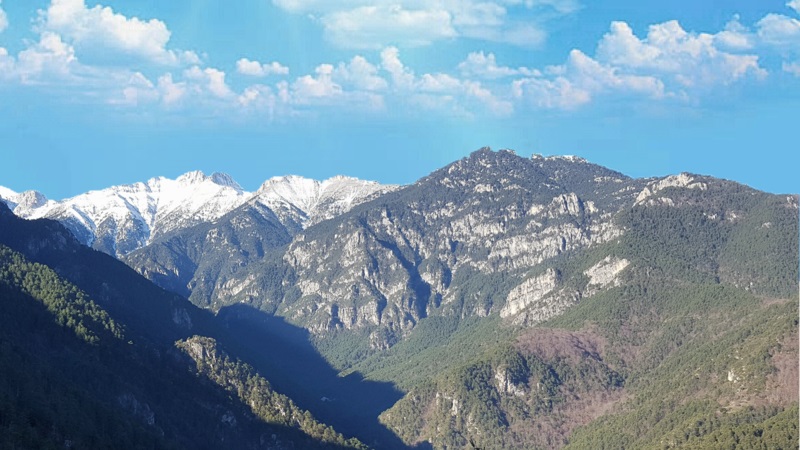The Creation of Mount Áitna
The Home of the Gods
In the highlands of northern Érevon, a range of snow-covered granite peaks rise over 5,000 yds. above the gently rolling Plains of Andawan to the south. They are called the Everlia, and they rise so steeply and so high that rain clouds struggle to pass over them, resting instead in the hollows and valleys, and delivering to these hills an exceptional amount of rainfall.
In the spring and summer, the warmer air makes the clouds even denser, and violent thunderstorms echo off the stony walls of the dales and gorges, dropping the rains that have shaped this landscape for millennia. Streams and waterfalls rush down the steep sides of these mountains, while underground rivers have cut through them some of the largest caves in Heremonia.
The highest mountain in the Everlians is Mount Áitna, the “Home of the Gods.” It is easy to understand how this mountain gained such a reputation. It is not difficult to envision ancient men and women watching bolts of lightning descend from its shrouded heights amidst the roaring thunder, and imagining Dagodaire and Tornach residing there.
Surviving texts bring us two myths which attempt to account for the creation of Mount Áitna. The older tale, found in Oisín’s epic poem An Scéal Faoi Thógáil Érevonaigh (The Tale of the Taking of Érevon) is more prevalent in the north. It attributes the mountain’s creation to Dagodair himself. The shorter alternative version, preferred in the south, comes to us in Glasléad of Galney’s monumental history of Érevon and the Kiltic people, Bunú na Ríochta (“The Founding of the Kingdom”), and describes an origin story involving Dagodair, Torre and Tornach.
Dagodáir began walking east toward the smoke, and as he approached it he saw that it rose from the chimney of a small cottage surrounded by a green garden. As he walked closer, Dagodair spied in the garden a young maiden, but as he arrived at the gate she turned and he saw she was an old crone.
Dagodair asked, “Kind woman, I am thirsty. Could you spare me some water?” The woman replied, “Water is scarce in this land. I have none to spare.” Her response surprised Dagodaire, as it was the strict custom that all travelers were to be shown hospitality.
Dagodaire spoke again, “Kind woman, I am thirsty, and it is plain to see that you have water to give. Will you not share some with a weary traveler?” The old crone again replied, “I have none to spare.”
Dagodaire became angry. “Kind woman,” he shouted. “Give me water to drink.” She looked at him impassively and said, “I have no water to spare.”
Enraged, Dagodaire turned and stomped his right foot on the ground, and then his left foot, driving deep depressions into the land, into which water began to flow. The water rose rapidly, forming the Crofin Sea.
As the sea rose it engulfed the old crone and her cottage, drawing them under the water. To save herself from drowning, the old crone turned herself into a stiurjíon, and her descendants can be found in the Crofin Sea even today.
When Dagodaire returned to Érevon he saw a great mountain had risen up over the land on the opposite side of the world from where he had pushed the land down in his anger. Because of its position of command over the land, Dagodaire chose that place for his throne, and the mountain was called Áith n’Déthaigh.
As he dug, Torre was mindful of his promise to Dagodaire, and carefully placed the land he dug into a pile. After many days he was finished, and the water flowed in to form the Torrean Sea. And from its shores rose up a mighty range of mountains which we now call the Everlia. At the highest point, Torre fashioned a throne, as a gift to his brother Dagodaire.
But upon seeing this, Tornach the God of Thunder became jealous of Dagodair. He drove his iron chariot and team of black staileanna over the mountain again and again, creating deep gorges in its sides. Determined to stop the destruction of his high throne, Dagodaire hurled bolts of lightning at Tornach, driving him away. He then directed his fiery spears at the mountain itself, hardening the stone into the form we see today.
In the spring and summer, the warmer air makes the clouds even denser, and violent thunderstorms echo off the stony walls of the dales and gorges, dropping the rains that have shaped this landscape for millennia. Streams and waterfalls rush down the steep sides of these mountains, while underground rivers have cut through them some of the largest caves in Heremonia.
The highest mountain in the Everlians is Mount Áitna, the “Home of the Gods.” It is easy to understand how this mountain gained such a reputation. It is not difficult to envision ancient men and women watching bolts of lightning descend from its shrouded heights amidst the roaring thunder, and imagining Dagodaire and Tornach residing there.
Surviving texts bring us two myths which attempt to account for the creation of Mount Áitna. The older tale, found in Oisín’s epic poem An Scéal Faoi Thógáil Érevonaigh (The Tale of the Taking of Érevon) is more prevalent in the north. It attributes the mountain’s creation to Dagodair himself. The shorter alternative version, preferred in the south, comes to us in Glasléad of Galney’s monumental history of Érevon and the Kiltic people, Bunú na Ríochta (“The Founding of the Kingdom”), and describes an origin story involving Dagodair, Torre and Tornach.
Oisín’s Version
One fine day Dagodáir the All Father was walking on the high steppes of Heberia. The sun was hot and the air was dry, and Dagodáir became thirsty. He looked around him, and for as far as the eye could see the land was parched and barren – neither river nor stream, nor lake nor pond from horizon to horizon. Then he saw a column of smoke in the east.Dagodáir began walking east toward the smoke, and as he approached it he saw that it rose from the chimney of a small cottage surrounded by a green garden. As he walked closer, Dagodair spied in the garden a young maiden, but as he arrived at the gate she turned and he saw she was an old crone.
Dagodair asked, “Kind woman, I am thirsty. Could you spare me some water?” The woman replied, “Water is scarce in this land. I have none to spare.” Her response surprised Dagodaire, as it was the strict custom that all travelers were to be shown hospitality.
Dagodaire spoke again, “Kind woman, I am thirsty, and it is plain to see that you have water to give. Will you not share some with a weary traveler?” The old crone again replied, “I have none to spare.”
Dagodaire became angry. “Kind woman,” he shouted. “Give me water to drink.” She looked at him impassively and said, “I have no water to spare.”
Enraged, Dagodaire turned and stomped his right foot on the ground, and then his left foot, driving deep depressions into the land, into which water began to flow. The water rose rapidly, forming the Crofin Sea.
As the sea rose it engulfed the old crone and her cottage, drawing them under the water. To save herself from drowning, the old crone turned herself into a stiurjíon, and her descendants can be found in the Crofin Sea even today.
When Dagodaire returned to Érevon he saw a great mountain had risen up over the land on the opposite side of the world from where he had pushed the land down in his anger. Because of its position of command over the land, Dagodaire chose that place for his throne, and the mountain was called Áith n’Déthaigh.
Glasléad of Galney’s Version
It came to pass that Torre, God of the Sea, approached Dagodaire and demanded the right to expand his kingdom by creating a new sea. Dagodaire agreed, on the condition that any land destroyed by Torre must be returned to Dagodaire. Torre set about his task, and began digging.As he dug, Torre was mindful of his promise to Dagodaire, and carefully placed the land he dug into a pile. After many days he was finished, and the water flowed in to form the Torrean Sea. And from its shores rose up a mighty range of mountains which we now call the Everlia. At the highest point, Torre fashioned a throne, as a gift to his brother Dagodaire.
But upon seeing this, Tornach the God of Thunder became jealous of Dagodair. He drove his iron chariot and team of black staileanna over the mountain again and again, creating deep gorges in its sides. Determined to stop the destruction of his high throne, Dagodaire hurled bolts of lightning at Tornach, driving him away. He then directed his fiery spears at the mountain itself, hardening the stone into the form we see today.





Comments